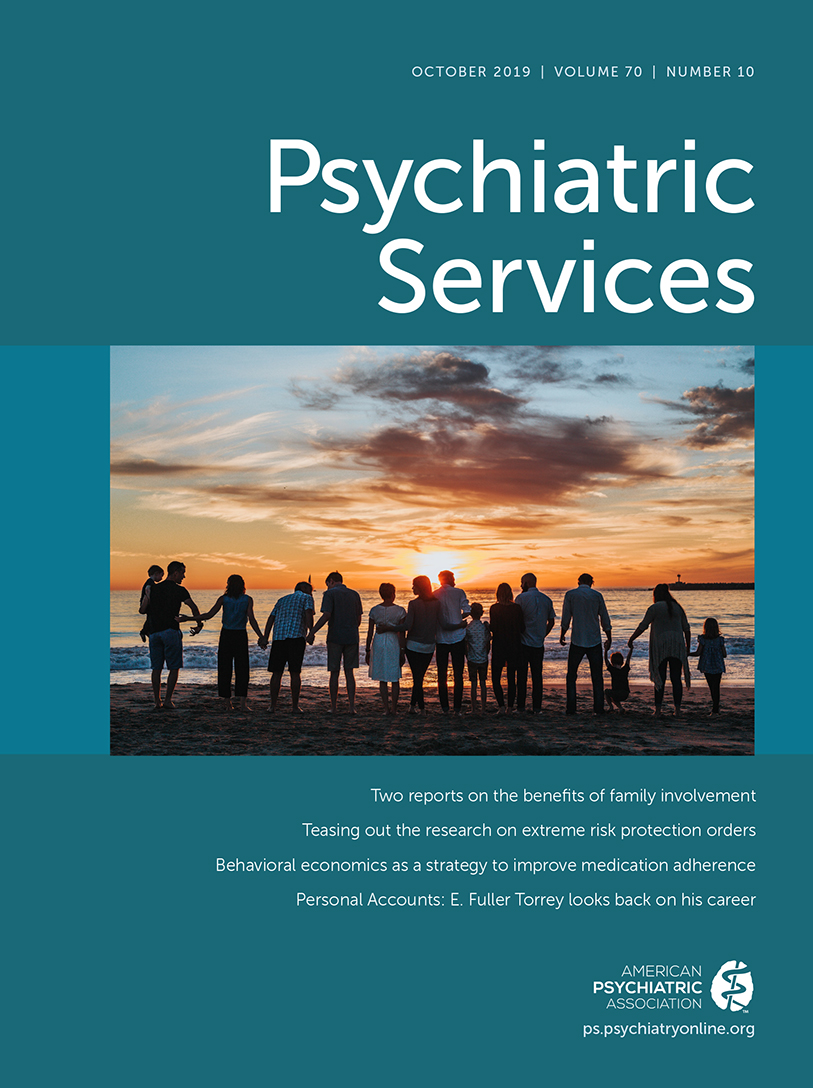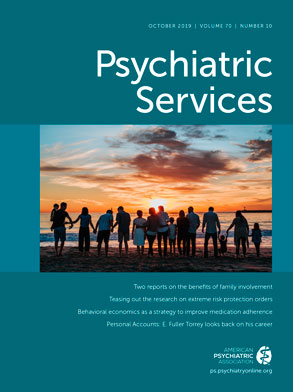In 2017, U.S. jails and prisons processed over 11 million admissions and held approximately 2.2 million incarcerated individuals at a given time. Compared with the general public, incarcerated individuals suffer from high rates of mental disorders, substance use disorders, infectious diseases, and other chronic medical conditions (
1). Correctional facilities have a duty to provide health care to incarcerated individuals (
2); for various reasons, however, these patients may receive treatment in community health care settings, including mental health facilities. Reasons for utilizing community-based care may include transfers for evaluation in emergency departments, hospitalizations, and referrals to specialists who are unavailable in correctional settings (
3). In 2015, Virginia and New York each spent approximately one-quarter of their prison health budgets on off-site hospital care (
3).
Outside correctional settings, health workers may be unfamiliar with caring for incarcerated patients and may face unusual circumstances, such as shackles on patients; restrictions against visitation or against providing certain information to patients and their families; and difficulties maintaining patient privacy in the presence of correctional officers (
4–
6). For example, Texas Tech University Health Sciences Center El Paso published guidelines about treating incarcerated patients brought to their facilities, stating, “Do not provide any information to prisoners about the need for return visits. . . . Do not ride elevators with prisoners and their officers. . . . Officers will decide what prisoners may do while in our facility. . . . The sooner [prisoners] are treated and on their way back to their facility the less risk to clinic staff and other patients/visitors. . . . Treat all prisoners as potentially dangerous to you and the staff” (
7).
Deviations from usual care in the treatment of incarcerated patients have also provoked considerable litigation. For instance, several lawsuits have challenged the shackling of incarcerated patients, particularly pregnant prisoners. In a highly cited federal case, incarcerated females in the District of Columbia correctional system filed a class action lawsuit over the mistreatment of female inmates, including the shackling of pregnant prisoners. The U.S. District Court for the District of Columbia held in 1994 that “while a woman is in labor and shortly thereafter…shackling is inhumane” and “poses a risk so serious that it violates contemporary standards of decency” (
8). An appeals court later overturned many of the findings in this case, but the ruling related to shackling remained unchallenged, and subsequent court decisions have affirmed that shackling a pregnant patient during labor may violate her constitutional rights (
9–
11). By comparison, a 2013 court decision found that “the right to be free from shackling during labor is not unqualified,” (
11) and, more than two decades after the 1994 decision, litigation continues over the legality of shackling pregnant prisoners and the circumstances in which this practice may be permissible (
12).
Community mental health professionals may face several dilemmas when caring for incarcerated patients, and this column explores whether treatment of incarcerated patients should be managed differently than treatment of other patients.
Treating Incarcerated Patients Outside Correctional Settings: A Case Example
Mr. L is a 66-year-old male with a history of mild cognitive impairment, psychosis, insomnia, type II diabetes, and hypertension. He is incarcerated, and a prison physician referred him to a community geriatric psychiatry clinic for consultation regarding behavioral disturbances, medical workup, and treatment recommendations.
On the morning of Mr. L’s appointment, a correctional officer calls the clinic and asks, “Can we bring the inmate through a back door and directly into a room for the appointment?” The administrative assistant handling the call is uncertain how to respond and speaks with the geriatric psychiatrist, Dr. T, scheduled to see Mr. L. The psychiatrist asks, “Why can’t the patient come into the waiting room?” The assistant replies, “The officer mentioned security. He also said the patient will be shackled, which could draw attention.” Hurrying to another appointment, Dr. T asks the assistant to “help them do whatever they usually do.”
Later that day, correctional officers transport Mr. L in an orange jumpsuit and shackles to the clinic. Following instructions from the clinic staff, the officers take Mr. L through a back door into the building, up a rear stairwell, and into an empty clinic room, where he and the officers wait.
When Dr. T arrives for the appointment, she greets Mr. L and introduces herself. Mr. L looks down and remarks, “Am I too scary to use the front door?” Dr. T is taken aback, now unsure whether she should have accommodated the correctional officer’s request.
Reasons to Use Different Protocols for Incarcerated Patients
Security is the foremost reason for establishing different protocols, including use of atypical entrances, for incarcerated patients in community health care facilities. Correctional staff are responsible for maintaining safety and for keeping incarcerated patients in custody during transportation. Because community health care settings, including mental health facilities, often lack security measures present in jails and prisons (e.g., sally ports, metal detectors, circulating officers), transporting incarcerated patients to these facilities brings security risks, such as detainees acquiring contraband, taking advantage of unsuspecting health workers, or escaping. One study identified 99 prisoner escapes from hospitals between 2010 and 2011 (
13); in some cases, detainees wrestled weapons from officers, and these escapes were associated with 49 injuries and two deaths (
13).
To mitigate these security risks, correctional staff and health workers at community health care facilities may follow certain protocols, such as keeping incarcerated patients out of busy public areas like waiting rooms or lobbies, that deviate from usual patient care. For instance, several states, including Connecticut, Colorado, Louisiana, New York, New Jersey, Ohio, Texas, Virginia, and Wisconsin, have established “inmate-only” secure areas in specific hospitals for minor inpatient and outpatient treatment (
3). One policy at Texas Tech University Health Sciences Center El Paso states, “Inmates will utilize a back or side entrance into the clinic. At no time should an inmate use the main entrance or lobby of a clinic” (
14). Protocols at UMass Memorial Medical Center emphasize transporting incarcerated patients via “less-public routes” in their facilities (
15).
Using different protocols, such as alternate entrances, at community health care facilities might help expedite care for incarcerated patients. In addition to introducing security risks, transporting detainees for off-site health care can incur significant costs for correctional facilities in terms of staff time and money; these trips require coordination between facilities, remove correctional staff from their posts, and often necessitate overtime pay for traveling staff (
3).
Consideration for the well-being of incarcerated patients may be another reason to separate their care from that of other patients. In the case example, the correctional officer mentioned that Mr. L’s shackles could draw attention in the waiting room. Incarcerated people face profound public rejection and self-stigma based on stereotypes of being dangerous, untrustworthy, or immoral. By setting up alternate protocols, such as separate entrances or waiting areas, health workers and correctional staff might protect incarcerated patients from unwanted stigmatization in public areas and provide them with additional privacy, since these patients may not want others to know about their imprisonment.
The well-being of other patients and staff might also factor into these decisions. In the case described above, patients in the waiting room may already be hesitant about presenting to a psychiatry clinic; seeing Mr. L in an orange jumpsuit and shackles may exacerbate their fears about mental illness and what it means to receive psychiatric treatment. Some patients or staff may have a history of traumatic experiences, such as arrest, police brutality, or past incarceration, and the presence of armed correctional officers and a patient with shackles might make them feel unsafe or exacerbate trauma-related symptoms. For example, a 2018 report from Nevada found that “doctors are reluctant to treat inmates” and that Nevada Department of Corrections staff “take inmates to the doctors’ offices through the back door usually before or after business hours to get treatment to avoid interaction with other patients” (
16).
Reasons Not to Use Different Protocols for Incarcerated Patients
A 2017 article notes, “basic fairness requires health care professionals to treat incarcerated patients as they would any other patient” (
17). Similar treatment, including bringing an incarcerated patient through a regular clinic entrance, might uphold the principle that, despite incarceration, this person deserves treatment and respect like any other person. Transporting incarcerated patients to off-site health care facilities requires some degree of enhanced security, given that prisoner-related security breaches, such as escapes, occur repeatedly at these sites (
13). However, the extent to which certain measures, such as separate entrances, shackles, and correctional officers in patient rooms, are necessary remains controversial (
4–
6).
Following different protocols for incarcerated patients could further distance health workers and members of the public from these individuals, potentially solidifying stigma against criminal offenders and keeping the effects of mass incarceration out of sight, out of mind. For example, hiding these patients from the public and transporting them through side or back doors might perpetuate stigma that incarcerated individuals are dangerous or aberrant, as demonstrated in the case example by Mr. L asking whether he is “too scary” for the front door.
Moreover, using alternate protocols for incarcerated patients might complicate medical care by disrupting the patient-clinician alliance. Incarcerated patients may perceive that health workers are part of the correctional apparatus and its punitive functions; as a result, these patients may mistrust clinicians tasked with caring for them (
6) and may hesitate to disclose medically relevant information that they fear might be shared with correctional staff. Demonstrating this potential disruption to the patient-clinician alliance, guidelines from Texas Tech University Health Sciences Center El Paso recommend to staff, “Do not become friendly with prisoners. You do not want them to think you are ‘on their side’” (
7).
Suggestions for Treating Incarcerated Patients in Community Facilities
Because millions of individuals are incarcerated in the United States each year, community health care facilities, including mental health clinics and hospitals, should develop written policies on caring for incarcerated patients, explaining any deviations from usual care. Collaboration with organizations such as the National Commission on Correctional Health Care (
18) and the International Association for Healthcare Security and Safety (
19) may be useful for developing these standards and for exploring new opportunities, such as telemedicine (
20), to bridge divides between correctional settings and community health care settings. Additional research is needed for crafting evidence-based policies that maximize health, maintain public safety, protect privacy, and reduce stigma when incarcerated patients require treatment outside correctional settings. Although randomized trials may be difficult given the complicated medicolegal implications, observational data might offer useful insights for developing such standards (
6).
When specific policies are unavailable, health workers may find themselves facing complex logistical and medicolegal decisions around treating incarcerated patients. As healers, health professionals must never treat incarcerated patients differently from other patients in order to inflict punishment. Incarcerated patients are a vulnerable population, and health professionals must exercise additional vigilance to ensure that these patients receive equitable treatment (
17). If specific security measures appear disruptive to patient care, clinicians should elicit incarcerated patients’ perspectives and work with correctional staff to weigh competing concerns related to security, health, privacy, and stigma (
19). Throughout, health professionals should remain mindful that incarcerated patients are precisely that—patients.

